Section 3: Signs of Creation in the Seed
It is God Who created the heavens with no support – you can see them – and cast firmly embedded mountains on the Earth so that it would not move under you, and scattered about in it creatures of every kind. And We send down water from the sky and make every generous species grow in it. (Qur’an, 31:10)
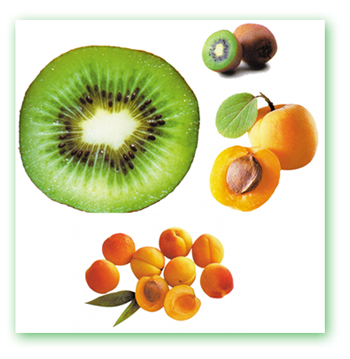 |
|
The kiwi has numerous tiny seeds. The apricot, however, has only one, very well protected inside a hard shell.
|
As mentioned in the previous section, a seed basically consists of a seed coat, a nutrient reserve and an embryo. Though the basic structure is the same, the amount of nutrients contained in each seed's reserve, the type of surrounding protective membrane, its thickness, the shape and taste of the fruit enclosing it differ greatly from one another. Everything from the shape to the color of the seed coat and the materials it is made from varies according to the plant's species and habitat.
Seeds reveal marvelous wonders of creation. To give one example, an apricot contains just one pit, or seed, which is well protected by a hard shell. The fleshy interior tastes sweet and is suitable for eating – good food for birds, rodents, insects and other animals as well as people. The fact that the fruit consists of two such sections is also opportune for the plant, for when the apricot is eaten, the seed enclosed in the hard casing at the fruit’s center is exposed, and thus has a chance of germinating in a suitable place and growing into a new tree.
In contrast to the apricot, the kiwi is a fruit that contains numerous little edible seeds, rather than just one. The seeds of this fleshy fruit are grouped together. And because they are so numerous, even if one part of the fruit is eaten, their chances of sprouting into a new plant are increased.
Dry fruits usually have some architectural features to protect and distribute the seed. As an example, take the tufts that crown the thistle. As you’ll soon see in greater detail, these little parachutes carry their precious cargo, the reproductive cells, to distant places on the wind.
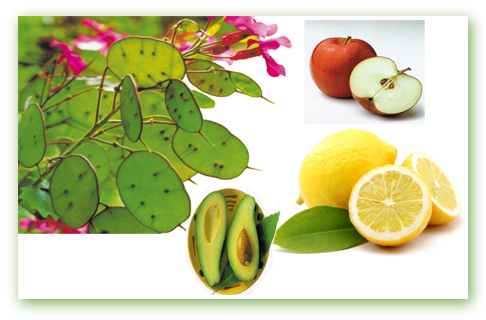 |
|
In seeds there is as great a variety as there are plants in the world. When we consider that the seed of every plant has a different shape, contains a different amount of nutrient reserve, and has a coat with a different thickness, we can see evidence of their wondrous creation.
Dry seeds often have a special structural feature like tufts to let them be transported. Seeds of Epilobium glaberrinum shown below are dispersed by the wind. The seedpods consist of four parts. As soon as these separate, the plant's tufted seeds disperse in the air and carried away in the wind.
|
The dry fruits that have multiple seeds open up to distribute them. This kind of fruit is called dehiscent. They have a thick and resilient seed coat that protects the embryo and the nutrient reserve. As they turn green, the seeds are compacted together and exert pressure on one another. They may be of very different colors, shapes and textures, and may have different features such as wings, feathery strands or a fine membrane.
Dry fruits with multiple seeds are very diverse, taking many forms such as pods, bladders, grained etc. A few examples include:
 |
|
It is possible to tell how seeds are distributed by looking at their structure. While these feathery seeds are dispersed by the wind, those of the plant shown above are disseminated when the plant has dried out.
|
Montbretia, with round, bright orange seeds packed into triple capsules. The plant waits for the wind or a passing animal to shake it to distribute its seeds.9
The leguminous plants form a very broad category, within which each species has its own distinct shape and features. Seeds of the pea plant, for instance, are arranged in an orderly row. On the other hand, Colutea arborescens has air-filled bladders that burst noisily. The most incredible of these plants is the catclaw or black mimosa (Mimosa pigra) with its pods, each one of which contains a seed and is shaped like a hairy claw.10
These are just a few examples of plant seeds’ functional structures. Considering that every plant has a different seed structure, the variety and degree of perfection in seeds is remarkable.
|
|
| All seeds generally have the same contents. As you can see, however, in the picture, the shape of the seed varies according to the species of plant. God has created seeds in an infinite variety. |
Special Materials in the Seed Coat
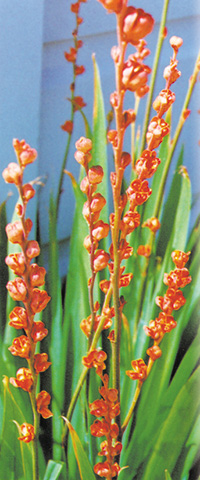 |
|
The seeds of the Montbretia plant shown below are dispersed by the wind, though animals also help in their distribution.
|
Not only do the seeds have different structures; but the seed coats too are created with all their requirements.
The embryo inside the seed is extremely valuable – and vulnerable, needing to be carefully protected until the new plant has completely developed. This protection is provided by the seed coat, which shows variations in each species of plant. The degree of protection the seed is afforded corresponds to the resilience of the seed coat’s material, which also affects the seed’s ability to float or to be carried by the wind.
The seed’s outer covering takes a great variety of forms, with many interesting features. Some are coated with a bitter substance to deter enemies. Some are rich in a chemical called tannin that prevents the seeds from rotting. The seed coats of several plant species are covered in a kind of jelly-like substance, which consists of complex sugars fused with proteins, and swells easily on contact with water allowing the seed to easily stick to damp materials. As you’ll see subsequently, this characteristic plays an important part in the germination phase.11
The protective outer layer of a seed is usually extremely tough, protecting it from the external forces it will encounter. For example, in the final phase of some seeds’ development, some impervious waxy substances are deposited on the outer surface that make the seed resistant to water and gas penetration.12 Depending on the variety of plant, seed coats may be covered with materials as fine as the membrane covering a bean or as hard and woody as a cherry stone. Seed coats that must be water-resistant are tougher and thicker than the rest.
For a seed we frequently encounter in our daily lives, let’s use the bean as an example.
Depending on the variety, the bean may be enclosed in one or two coverings that protect the seed from harsh conditions such as cold air, drought or mechanical effects, in the same way as an overcoat. This is where all contact is made with the outside world.
 |
|
The seeds of the pea plant are arranged in tidy rows and protected in special little pods.
Wherever in the world they grow, all peas have the same perfect order, wonderful color and taste, due to the information installed in them by God.
|
At the point where the bean has broken off from where it was attached to the pod, there is an oval mark. On careful examination, a small opening called a micropyle is visible. Because of this opening’s function, it can be compared to the navel of a baby. Through this small passage, the pollen tube used to fertilize the female reproductive cell in the ovule once entered. Now, when the time comes, water enters through this opening and allows the seed to germinate.13
As mentioned already, the seed coat’s thickness is specially regulated according to the type of plant. Every seed coat is neither too thick nor too thin, but has just the right thickness to let the plant develop in its home environment. A seed with a thin coat can be destroyed more easily by various external influences. For this reason, all seeds have coats of the most suitable thickness for their respective habitats. Seeds with very thick coats can survive all kinds of difficult conditions, but the disadvantage of an exceptionally thick coat is that the embryo has problems breaking out of the seed.
Moreover, close examination reveals that seeds distributed by animals have coats thin and easy enough to pierce for the animals to take an interest in their contents. But at the same time, the structure of the coats covering these seeds makes them unattractive to all seed-eaters.14
From the explanations given so far, it is evident that seeds, which appear to be so simple, are actually structured in great detail. Their characteristics, from the proportions of the materials they contain to their content and protective outer layers, all vary according to environmental conditions. But how did this variety and detail come into being?
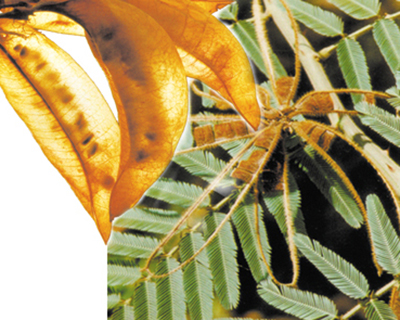 |
|
Each of the pods of the mimosa plant (above) contains a seed and is in the shape of a tufted thorn. On the other hand, Colutea arborescens (left) disperses its seeds by bursting its air-filled seedpods.
|
When we look in books propounding evolutionary theory to answer such questions as “How?” and “Why?”, we find that evolutionists prefer to use obscure expressions and deceptive methods. A book entitled Evolution has this to say on the subject of seeds and fruits:
The outer casing of a seed is strong enough to withstand the molar teeth and intestinal acids and enzymes of various animals, and an atmosphere lacking in oxygen. Moreover, this seed casing has been evolutionarily designed so as to protect the embryo until the conditions for germination are suitable from factors causing it to germinate at the wrong time and seed-eating animals.15
You'll note that having enumerated some of the remarkable features of seeds, the use of the expression "evolutionarily designed" tries to give the impression that they came into being through evolution. But the paragraph above by no means explains how seeds came into existence, because it merely mentions the perfection in their creation. The phrase “evolutionarily designed” actually has no meaning at all.
Moreover, this expression is untenable in itself, because the concepts of “evolution” and “design” are diametrically opposed. It’s unimaginable that the process of evolution could produce a design, for evolution is claimed to depend on coincidences, and the very existence of an order reveals the existence of a conscious mind. Accordingly, if there is an order, it follows that concepts such as evolution, coincidence and chance can have no bearing. Signs of creation in seeds are evident proofs that they are not the product of evolution but are created by Almighty God.
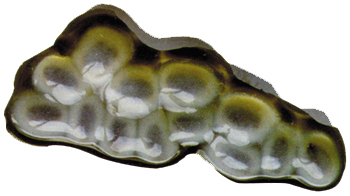 |
|
These jelly-like objects belong to a variety of basil known as Ocimum basilicum. A few minutes after its seed coats come into contact with water, they start producing a jelly-like substance, and thus assume the above shown appearance. Seeds of this variety of basil are used in Thailand and other regions of the Orient, particularly added to fruit juice. (Grains de Vie, p. 24.)
|
 |
|
The heavy seeds of Ipomoea murucoide are able to float on the air due to these fine hairs. Also thanks to these hairs, the seeds roll along the ground with the wind. (Grains de Vie, p. 25.)
|
Let an example clarify this further. Suppose that you visit an art gallery and come across a wall full of drawings, each depicting the seed of a different plant and its related details. Were you to ask the gallery director who drew all these pictures, what if you were told, “These were not drawn by any artist; they were evolutionarily designed with the help of coincidences”? You would find such an answer highly unreasonable, and continue to believe that they were the work of an artist.
Just as you would not believe in the “evolutionary design” of such drawings, neither would you accept that seeds – living structures containing all the information about a plant, which under the right circumstances can germinate to produce hundreds of thousands of different kinds of fruit and flowers – could come into existence as a result of unconscious coincidences. So the question should be who essentially created these perfect systems, how plants were structured accordingly.
With their claims of coincidence, evolutionists can never explain the very clear plan in the structure of seeds, a plan that evidently has not come about as the result of coincidences. Just as every drawing must have an artist, there is someone behind every plan. The perfectly planned systems in seeds is the work of God, with His eternal wisdom and supreme power. The wisdom that can be seen in every stage of the life of plants is clear proof that they are the creation of the Almighty God.
 |
 |
|
The seed coat is not the only factor to protect the seed embryo and aid in its dispersion. In some species, these functions can also be carried out by the fruit. For instance, in Nicandra physaloide, whose various stages of development are shown in the pictures, the ovule develops into a swollen fruit full of seeds. If part of the top layer is removed from this fruit, the seeds appear to have grown to a size 500 times larger than the ovules' original dimensions. The seeds are connected to the mother plant by bonds that share the same nature as an umbilical cord. (Grains de Vie, p. 26.)
|
Beans enclosed in a protective skin.
 Pomegranate seeds protected by their fruit’s juicy red flesh. Pomegranate seeds protected by their fruit’s juicy red flesh.
These seeds, with their extremely appealing appearance, are a product of God’s perfect creation.
|
|
It is He Who sends down water from the sky. From it you drink and from it come the shrubs among which you graze your herds. And by it He makes crops grow for you and olives and dates and grapes and fruit of every kind. There is certainly a sign in that for people who reflect. (Qur’an, 16:10-11)
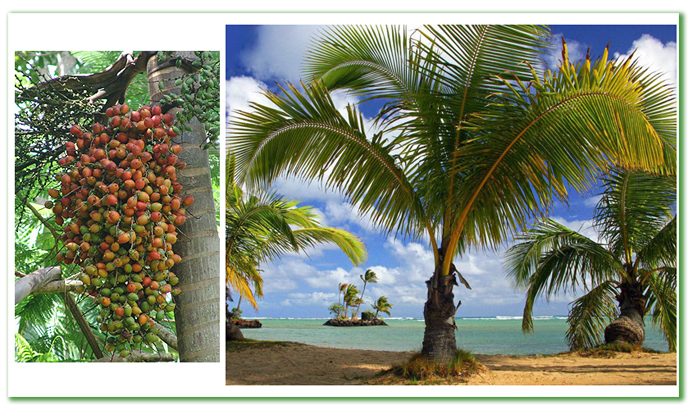 |
|
The seeds of the palm tree are contained in the fruits shown below. When the seeds fall to earth and the right conditions are available, a palm tree starts to grow that may be meters tall.
|
 |
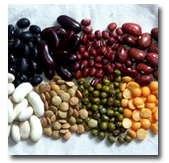 From the dry seeds at left have grown the brightly colored, sweet-scented flowers in the pictures below. This fact of creation should be given all due thought. From the dry seeds at left have grown the brightly colored, sweet-scented flowers in the pictures below. This fact of creation should be given all due thought.

|
 |
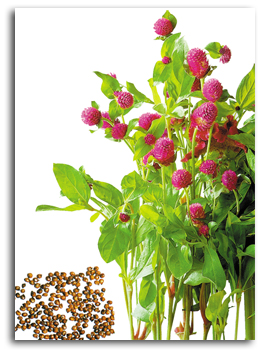
Gomphrena and its seeds
|
|
The pictures above show a cherry pit and a cherry tree, which has grown, blossomed, and will in time bear fruit in accord with the information contained in this cherry pit. The picture to the right shows a kind of wild fig tree. These gigantic trees, standing meters tall, have also grown from little seeds like the cherry tree with its sweet tasting and perfectly colored fruit. (The small seed in a human hand below is of the fig tree.) All of these trees' characteristics are perfectly encoded in their seeds. Moreover, the same information has been encoded in the same seeds for millions of years, and for this reason, the identical plants always germinate from the same seeds. With the information He has installed in seeds, God shows us that He has power over all things.
|
 |
|
In these little seeds (shown above) is encoded all the information on the tree (left) that grows to a height of 30 meters (98 feet), including such characteristics as the tree's number of leaves, its height, and whether it will bear fruit. Moreover, all this information has been coded into the same seeds in the same way since the beginning of time. The same trees have always grown from the same seeds.
|
 |
There are many different flowers, trees, fruits and vegetables on Earth, a variety created by information stored in the seeds of plants. left: iris and its seeds, right: cyclamen and its seeds.
|
 |
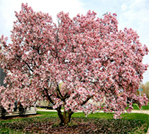 1-4) At night, the magnolia closes its petals only slightly. This enables insects to visit it more frequently.
5) The flower starts to wither. The petals of the corolla will soon start falling to the ground.
6) The petals of the corolla fade.
7) The flower's pollinated ovule starts turning into a fruit.
8) The fruit ripens to become a beautiful red color.
9) Finally the fruits burst and reveal seeds ready to drop.
These seeds will later turn into the magnificent magnolia trees seen adjacent. |
|
Reasons for the Different Sizes of Seeds
|
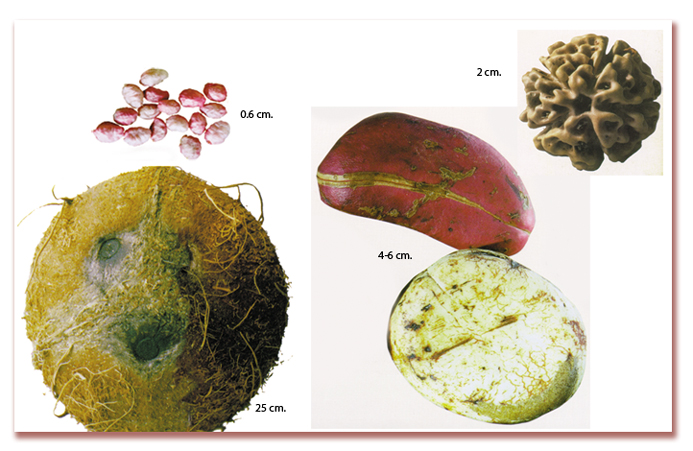 |
The size of seeds, as well as other features of plants, is determined in accordance with a plan. The coconut, for instance, which travels long distances by sea, is one of the biggest seeds. Its size ensures that there are enough nutrients to last during the long journey.
Orchids, on the other hand, have quite tiny seeds. Orchids are delicate plants that can only grow when the right medium, light and moisture conditions are available. Thus they produce seeds small enough to be carried by the wind and numerous enough to be deposited in at least some suitable locations. A single orchid flower can produce millions of seeds.16
The seeds of the beech tree, shown in the picture below left, are dispersed and start wafting through the air towards the end of autumn. These small seeds some 0.5 cm (0.2 in) in length sprout wherever there is enough light. Tropical seeds are often very bulky.
The mommay, shown below right, is one of these, with seeds usually about 5 cm (2 in) long. This seed can put down especially long roots to enable it to germinate in dry places. This reduces the risk of the seedling drying out due to lack of water.17
|
It is He Who sends down water from the sky from which We bring forth growth of every kind, and from that We bring forth the green shoots and from them We bring forth close-packed seeds, and from the spathes of the date palm date clusters hanging down, and gardens of grapes and olives and pomegranates, both similar and dissimilar. Look at their fruits as they bear fruit and ripen. There are signs in that for people who believe. (Qur’an, 6:99)
|




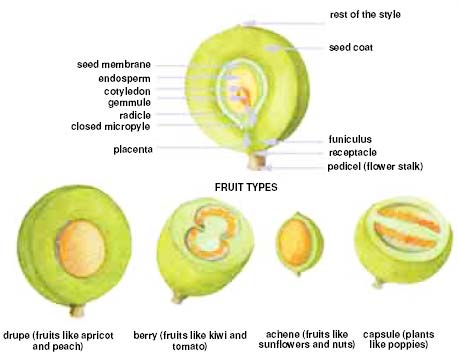







 Pomegranate seeds protected by their fruit’s juicy red flesh.
Pomegranate seeds protected by their fruit’s juicy red flesh.

 From the dry seeds at left have grown the brightly colored, sweet-scented flowers in the pictures below. This fact of creation should be given all due thought.
From the dry seeds at left have grown the brightly colored, sweet-scented flowers in the pictures below. This fact of creation should be given all due thought.





 1-4) At night, the magnolia closes its petals only slightly. This enables insects to visit it more frequently.
1-4) At night, the magnolia closes its petals only slightly. This enables insects to visit it more frequently.